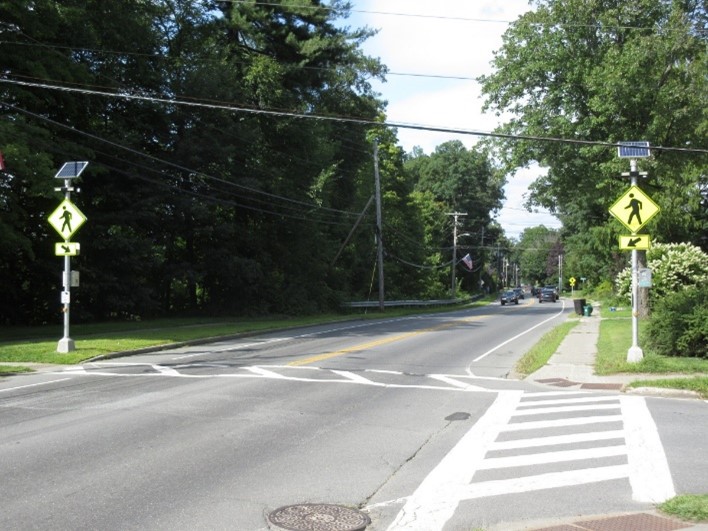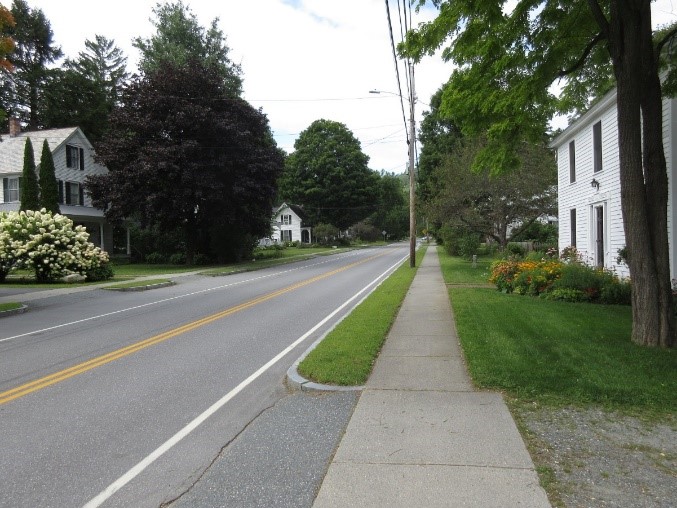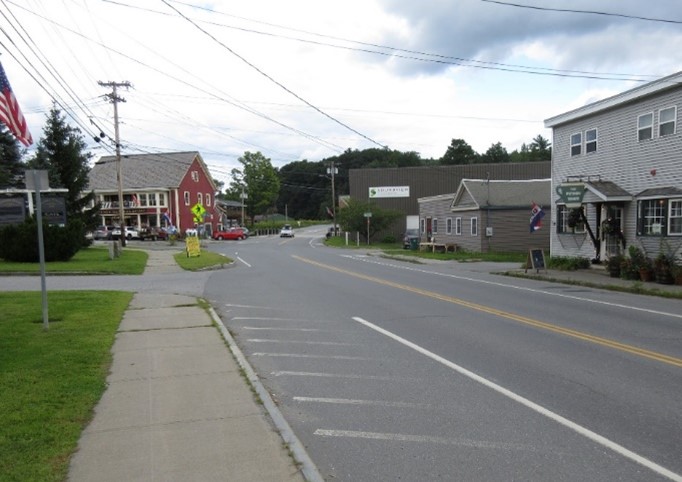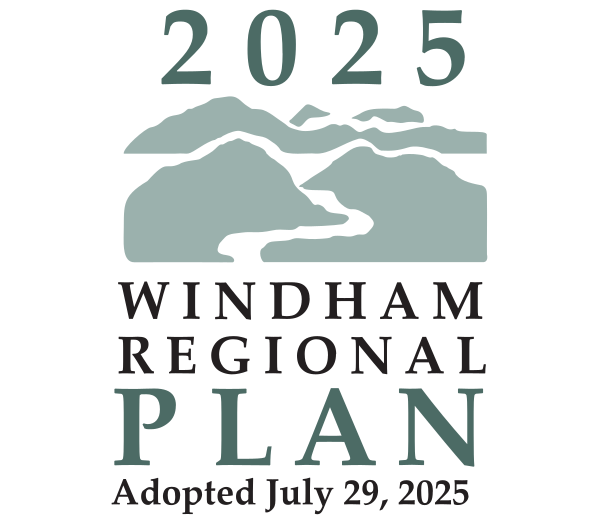Transportation
Bicycle and Pedestrian
Infrastructure for bicyclists and pedestrians is a major component of the transportation network in the Windham Region. Ensuring that our communities are safe, attractive, and efficient places for residents and visitors to walk and bike is vital to the broader social, economic, and cultural life of the region, and contributes greatly to the overall livability of our towns. Adequate bicycle and pedestrian infrastructure is a major factor in the economic vibrancy of our downtowns and villages; people are more likely to spend time and patronize local businesses and cultural institutions if they are provided with space that creates a pleasant, inviting environment to walk down the street.

Photo Credit: WRC
This touches on many aspects of life in the Windham Region, including public health, equity, and sustainability. It has been demonstrated that people are more likely to be physically active when they are able to conveniently access sidewalks and bike lanes that connect their home or place of work with important destinations. Many people are happy to walk half a mile from their home to the grocery store if they can do so on a well maintained, properly constructed sidewalk rather than on the narrow shoulder of a busy road. This passively introduces physical activity into the lives of people in our communities improving quality of life and overall health.
This is also critical to equity considerations in the region. Low income, older, and disabled residents are less likely to have access to a personal vehicle than the population as a whole. Sidewalks and bicycle lanes provide critical access to healthcare, education, employment, healthy food, and social engagement for vulnerable populations. Additionally, ensuring our towns are walkable and bikeable reduces dependence on personal vehicles for those who have access to them, reducing the environmental impact of gasoline powered vehicles as more people choose to walk or bike to their destinations each day.
Downtowns and Villages

Photo Credit: WRC
Bicycle and pedestrian planning is closely linked with land use. Compact settlement principles are central to making our region as walkable and bikeable as possible. Physical distance is an important consideration to how often one will walk or bike, rather than drive, as they go about their day. If you live in close proximity to your place of work, your school, the grocery store, healthcare facilities, restaurants, religious and civic institutions, you are much more likely to access them on foot or on your bicycle than if the nearest grocery store or church is several miles away on a narrow rural highway.
The historic settlement patterns of the Windham Region bolster bicycle and pedestrian planning efforts within town and village centers. Brattleboro, Bellows Falls, Wilmington, and our numerous villages provide convenient access to economic, cultural and recreational facilities to the many people who live within them. The Windham Regional Commission supports efforts to improve bicycle and pedestrian infrastructure in the region, including installing and extending new sidewalks where feasible, incorporating bike lanes into our existing roadways, and the construction of off-road mixed-use paths where on road infrastructure is not possible. This also includes incorporating Complete Streets principles and best practices into roadway design, in particular in our Region’s designated downtowns and villages.
Walkability in our downtowns and villages is closely linked with overall village vibrancy. The commercial, cultural and civic health of our downtowns and villages is central to increasing walking and biking in the region. Strong village centers with a variety of businesses and institutions that provide residents local options for grocery shopping, dining, hardware stores, and other services, will bolster efforts to improve bicycle and pedestrian connectivity in the region. The closure of a general store or a restaurant in a village can have a significant negative impact on active transportation in a community; residents who once may have walked to their local hardware store now must drive several miles away to access those same services.
The recent closure of a pharmacy in Londonderry is one such example. Residents now must travel more than 15 miles to the nearest pharmacy in Manchester for necessary medical care that was once easily accessible within the village. This has increased the strain on the ‘Neighborhood Connections’ On-Demand transit service, which now must schedule and transport those customers, increasing emissions, road miles, and limiting availability of trips for other riders.
Safe, efficient, and attractive bicycle and pedestrian infrastructure also has a positive effect on the cultural and economic character of towns. It is well demonstrated that when this infrastructure exists, people are much more likely to walk from their neighborhood to spend time in nearby commercial centers. This leads to an overall increase in activity in downtowns and villages and the overall customer base available to local businesses and cultural institutions.
While the majority of our existing bicycle and pedestrian infrastructure network is located in downtowns and villages, it is also important that residents in rural areas be able to safely walk and bike on their rural town highways. Limiting conflict between vehicles and other road users is important to ensure all residents can safely and comfortably walk and bike on our rural roadways.
Planning and Funding Challenges

Photo Credit: WRC
There are several common challenges that towns face in constructing new, or extending existing bicycle and pedestrian infrastructure. These include project costs, right-of-way acquisition, and planning within existing historic and narrow streetscapes. Such projects, particularly sidewalk construction projects, are very expensive, generally beyond the reach of what towns are capable of taking on without grant funding. A 2020 VTrans estimate put the average cost per foot of a concrete sidewalk with granite curbs at $317, meaning the construction of 1,000 feet of new sidewalk would cost in the range of $320,000. This number has almost certainly increased since the 2020 estimate and furthermore does not account for other costs associated with major construction projects, such as right of way, traffic control, project management, and built-in contingencies.
Ongoing maintenance of the existing bicycle and pedestrian network is also important. Winter maintenance in particular is a significant challenge to the effective year-round functioning of our pedestrian network. Sidewalks not being properly cleared of snow and maintained during the winter months creates substantial barriers to the overall walkability of our communities.
Right of way acquisition can be an expensive and controversial proposition. Acquiring privately-owned land for municipal projects is never a simple or easy process, and must be thoroughly considered and carefully navigated. Right of way acquisition is complicated by the narrow and dense historic streetscape of downtowns and villages in the region. The majority of our town and rural village centers were built out in the 18th and 19th centuries, and homes and roadways were laid out in a dense pattern of development intended to accommodate people walking or riding a horse, not motor vehicle traffic. This is compounded by national standards, outlined in the Manual Uniform of Traffic Control Devices (MUTCD), designed primarily with sprawling, 20th century suburban subdivisions in mind, often requiring much more space for transportation infrastructure than is reasonably available in our historic towns and villages. These Federal Highway Administration (FHWA) standards significantly complicates bicycle and pedestrian infrastructure projects and can create conflict between historic properties and the municipal right of way. These factors must be carefully considered when planning for sidewalks and bike lanes.
Navigating the State highway right of way is another significant challenge. Many of our region’s villages are centered on state highways. With the exception of Brattleboro, Bellows Falls, and Readsboro, which maintain Class 1 roads in their downtowns, Windham Region towns do not own or maintain the state highway right of way within their downtowns and villages. Towns are very limited in their ability to construct bicycle and pedestrian infrastructure or implement changes aimed at traffic calming on state highways, because such projects require towns to navigate an oftentimes complicated and time-consuming state review and approval process.
Grant funded projects through existing Agency of Transportation programs provides one avenue for towns to improve bicycle and pedestrian infrastructure on state highways in downtowns and village centers. VTrans staff are involved in the design and approval of any proposed infrastructure identified through these state grant programs, providing towns with a more easily navigable process towards implementation and construction of bicycle and pedestrian projects within the state highway right of way.
Scoping studies are a valuable tool available for towns to advance bicycle and pedestrian infrastructure projects. Towns may hire an engineering firm, oftentimes utilizing grant funding, to identify and design preferred solutions to improve walking and biking infrastructure. These studies include significant input from both residents and the Agency of Transportation, and provide towns with detailed plans and cost estimates that better position the town to seek construction funding.
